Noctua NH-U12P: Top Performance AND Silence
by Wesley Fink on March 20, 2008 8:00 PM EST- Posted in
- Cases/Cooling/PSUs
Installation
The installation instructions for the Noctua are so good they should be a model for other cooler manufactures. Details, drawings, and photographs are in the included manual and they are also available at the Noctua website. You first decide the mount kit you will use and then consider how you want the cooler to be oriented on the motherboard.
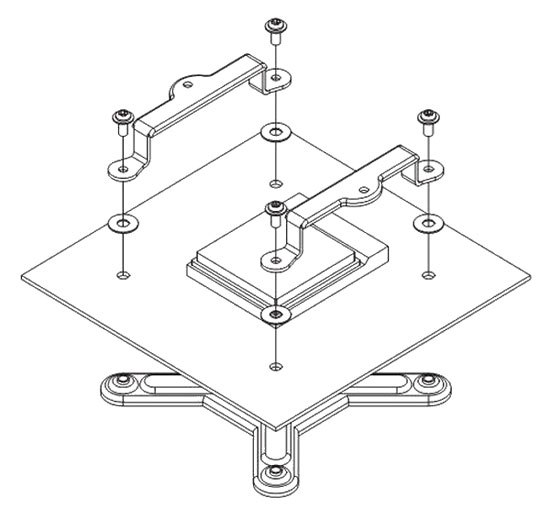
Noctua clearly spells out that the motherboard needs to be removed from the case to mount the cooler. Unfortunately, there is no way around this. In fact, the best way to mount the heatsink is to completely remove the motherboard and completely install the heatsink and fan before mounting in the case. This is not a problem with a new motherboard, but it can be very frustrating if you are just adding the Noctua cooler to an existing system.
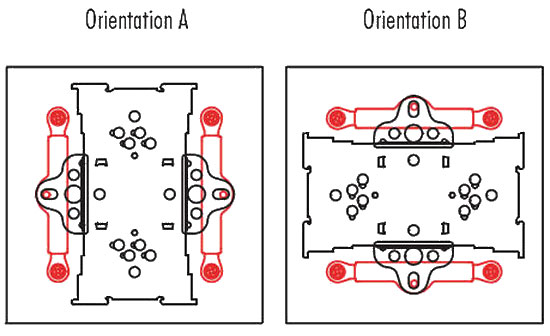
For Intel Socket 775, the adapter mount can attach with the mount holes in either direction. You can use whichever configuration fits your board best, since Noctua includes two sets of universal mount clips that allow any of the installations to be turned 90 degrees if desired.

Universal mounting clips, which work with all mount adapters, then screw into the heatsink base. Shown above are the standard universal mounts, but also included are optional horseshoe or u-shaped mounts, which install on the heatpipe sides and allow the Noctua cooler to be "turned" 90 degrees for mounting.
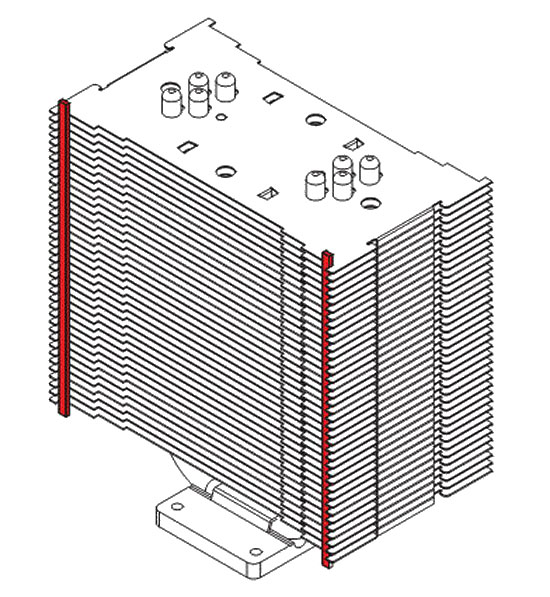
Self-adhesive elastomeric anti-vibration strips attach to the fan side mount(s) as shown.
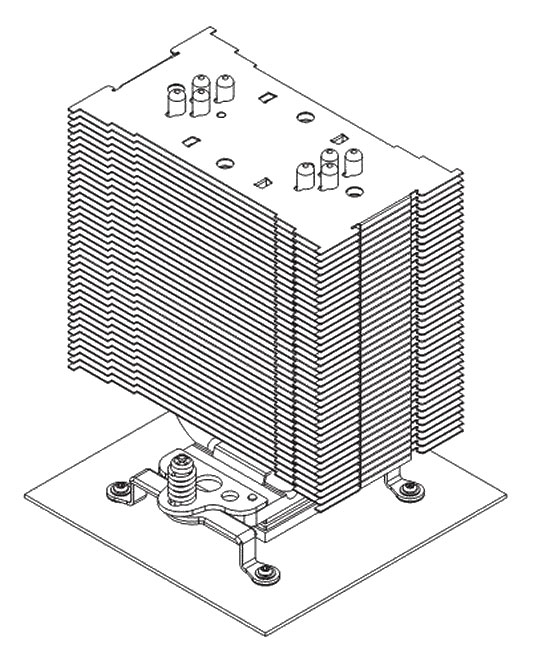
For most configurations, it is much easier to mount the heatsink to the motherboard before installing the fan(s). With the standard universal clips, the fan covers the screws used for mounting. With the "horseshoe" shaped mounts, the supplied screwdriver fits the round holes near the edge of the long direction of the heatsink if that configuration was chosen. This allows mounting the cooler even though the heatsink covers the mounting screws.
These are all thoughtful features, but they do not mean the Noctua is any easier to use than some other heatsinks. Manipulating and aligning the under-the-board brace and the aboveboard washers/clips/screws is frankly a pain. The good news is that the only thing you need to install at that step are the small clips - not the huge heatsink. However, the clear instructions make a difficult task more bearable with a little less urge to throw things out the window.
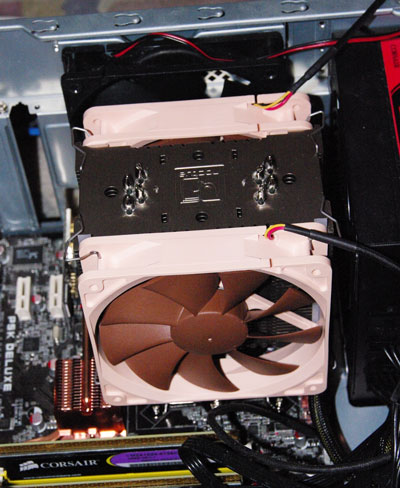
The Noctua NF-U12F is undeniably heavy and large, but the SecuFirm mounting system does provide what it promises. The finished install is very secure with no tendency at all to shift on axis. This does inspire confidence that the cooler is not going to fall off the motherboard. However, as with any large and heavy cooler, you probably should avoid moving the mounted cooler around a great deal, as it could stress the board. None of the large heatpipe towers are really designed for a LAN party computer that is often transported. (Ed: Wes must be talking about one of my AM2 systems. I had to jury-rig a vertical support contraption using zip-ties; otherwise, the HSF - an Arctic Freezer 7 Pro - causes some flex in the motherboard that causes the system to fail to POST.)










51 Comments
View All Comments
Wesley Fink - Friday, March 21, 2008 - link
We covered the Thermalright question head on in the Final Words. The Thermalright is not really set up for push-pull fans so you have to jury rig to get two fans on the cooler. We stated clearly the Thermalright would likely outperform the Noctua with the same fan, but if you wanted to conveniently mount two fans the Noctua was a better choice. Several readers have detailed instructions in the comments on how to mount two fans on the U120 eXtreme with Zip Ties.BTW we have tested every heatsink that was setup for multi-fans with both single and push-pull configurations, so your comment is not fair or accurate. The Thermalright is not really set up for two fans and you end up ripping open the fan wire holders if you try to force two fans. That is why people resort to jury-rigging and Zip ties. We hope Thermalright will address this in the near future as the Thermalright could othwerwise easily mount push-pull fans.
poohbear - Saturday, March 22, 2008 - link
oh ok, i dont recall reading that part of the article, my bad. yea if Thermalright isnt setup for a push/pull config from the factory, it wouldnt make sense to start making customizations just to accomodate it. cheers though.Mr Perfect - Friday, March 21, 2008 - link
At first I was little taken back by the airflow numbers of the fan, but then I noticed they where reporting in Cubic Meters Per Hour instead of the normal Cubic Feet Per Minute. Do you have CFM numbers so this fan can be compared to other fans on the market?Air Flow 92.3/78.5/63.4 cubic meters/hour (1300 stock/1100 LNA/900 ULNA)
poohbear - Friday, March 21, 2008 - link
its 54cfm @ 1300rpm.1 foot = 0.3048 metres; therefore
1 cubic foot = 0.3048*0.3048*0.3048 cubic metres = 0.028316846 cubic metres
and
1 hour = 60 minutes
therefore 1 m3/h = 0.5885778 cfm
hence 92 m3/h * 0.5885778 = 54.1491576 cfm
cheers.
JarredWalton - Friday, March 21, 2008 - link
Some simple math should suffice....1 cubic meter = 35.31467 cubic feet
60 minutes per hour
That gives 54.326/46.203/37.316 CFM, assuming they didn't just put in the wrong abbreviation.
Mr Perfect - Saturday, March 22, 2008 - link
Those numbers make much more sense. Other ~1000RPM 120mm fans also push in the 36ish CFM range.I was hoping Anandtech would put the CFM numbers in the article, it could be misleading if readers don't notice that the rates are not listed in the standard measurement. Anyone who buys a whole bunch of these $21 fans because they think they're putting out 63.4CFM at 900RPM and 12dba is going to be upset.
Baked - Friday, March 21, 2008 - link
If you're not overclocking, Freezer 7 Pro should be the no brainer HSF of choice.Baked - Friday, March 21, 2008 - link
Why bother wasting all that money on trivial performance gain. Just get the Freezer 7 Pro and be done with. Oh wait, I forgot about the epeen factor.poohbear - Saturday, March 22, 2008 - link
freezer pro 7 won't give u a 50%-70% overclock. a 70% overclock is hardly trivial, this is'nt video card overclocking wherein people usually get a 10%-15%.Basilisk - Saturday, March 22, 2008 - link
"freezer pro 7 won't give u a 50%-70% overclock"What am I missing here? As I read the charts in this article, the best listed cooler gave 34% OC on this CPU, while the AFP7 gave 31%. Maybe I'm missing the obvious; or are you reporting un-cited data?
My instinct was the same as others: the AFP7's the better performance/$$ unit, although this new kid has a slight upper end edge.
Not that I don't appreciate the fan improvements. My instinct is there are several further improvements to reduce flow turbulence [noise/efficiency], but we don't see much change in fans.